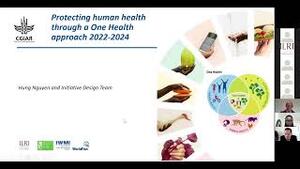
Launching research on benefits of nutrition and risks of food safety of animal source foods in Vietnam
In Vietnam, some people believe you shouldn’t turn the fish over while you are eating it, because it is bad luck and means the boat may turn over when it goes fishing. Food is one of the most important aspects of life and culture and unsurprisingly there are many beliefs, proverbs and taboos about growing, preparing and eating food. In parts of south Africa young boys should not be given kidneys to eat. In parts of east Africa, children should not be given eggs because it will make them bald like an egg. In parts of west Africa, children are considered pure and are given raw milk to purify the person who gives milk.
Animal source foods are excellent sources of nutrition and also a major cause of food-borne disease. In order to maximise the benefits and minimise the risks we need to understand consumption patterns. First of all: is the food produced and important in the community? CRP L&F has identified 9 value chains of great importance to smallholders and poor people. CRP A4NH is focusing on nutrition and food safety aspects of these important animal source value chains.
But, it is not enough for food to be available in a community. It must also be affordable, accessible and acceptable to the people who need it and can benefit from its nutrients. Many different factors influences the nutritional benefits and health risks of meat, milk, eggs and fish. These include whether people produce the livestock product or have to get it by other means, the quantities of animal source foods produced and sold, animal disease, the way foods are processed and prepared, and the amounts that different people in the community eventually eat.
These benefits of nutrition and risks of food safety of animal source foods are being investigated in a 3 country study supported by ACIAR and with international partners WorldFish, IFPRI, and the Royal Veterinary College UK. Vietnam is one of the target studies and here the work has been linked to another project called PigRisk which focuses on human and animal health risks associated with the pork value chain.
Qualitative assessment started with two workshops in Hung Yen and Nghe An, two provinces selected as CRP L&F study sites. Focus group discussions were held with five groups of stakeholders: farmers; input suppliers; butchers and retailers; public animal health services; and, public human health services. Stakeholders mapped the value chain and discussed constraints and opportunities. Excellent facilitation was provided by a large team from the national project partners and co-leads Hanoi University of Agriculture and Hanoi School of Public Health.
This will be followed by rapid qualitative assessment in 3 districts of each province. We have identified districts which represent rural to rural, rural to peri-urban/urban, and peri-urban to urban value chains. In each district we will conduct PRAs with farmers and consumers, FGDs with mothers of infants, and KII with input suppliers, transporters, butchers and also the health and livestock public services.




















